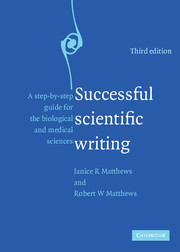Book contents
- Frontmatter
- Contents
- Preface
- Preface to the third edition
- 1 PREPARING TO WRITE
- 2 COMPOSING A FIRST DRAFT
- 3 VISUAL SUPPORT FOR THE WRITTEN WORD
- 4 VISUAL SUPPORT FOR THE SPOKEN WORD
- 5 REVISING TO INCREASE COHERENCE
- 6 IMPROVING WORD CHOICE, AND SYNTAX STYLE
- 7 ATTENDING TO GRAMMAR, NUMBERS, AND OTHER MECHANICS
- 8 THE REST OF THE STORY
- Appendix 1 Suggested responses to exercises
- Appendix 2 Excerpts from “Uniform requirements for manuscripts submitted to biomedical journals: Writing and editing for biomedical publication”
- Selected resources
- Index
Preface to the third edition
- Frontmatter
- Contents
- Preface
- Preface to the third edition
- 1 PREPARING TO WRITE
- 2 COMPOSING A FIRST DRAFT
- 3 VISUAL SUPPORT FOR THE WRITTEN WORD
- 4 VISUAL SUPPORT FOR THE SPOKEN WORD
- 5 REVISING TO INCREASE COHERENCE
- 6 IMPROVING WORD CHOICE, AND SYNTAX STYLE
- 7 ATTENDING TO GRAMMAR, NUMBERS, AND OTHER MECHANICS
- 8 THE REST OF THE STORY
- Appendix 1 Suggested responses to exercises
- Appendix 2 Excerpts from “Uniform requirements for manuscripts submitted to biomedical journals: Writing and editing for biomedical publication”
- Selected resources
- Index
Summary
Mend your speech a little, lest it mar your fortune.
– ShakespeareThe catch phrase “Publish or Perish” – or its more upbeat variant, “Publish and Flourish” – seems to have as much validity as ever in the minds of scientists everywhere. The scientific community has long emphasized quantity and quality of scholarly publications as a way to judge the eminence of scientists. Granting agencies appear to do the same. Scores received by renewal applications for National Institutes of Health funding for research in universities and hospitals have been shown to correlate very strongly with the number of publications resulting from NIH grants. Perhaps it is not surprising that the publication rate of scientific information doubles about every 12 years (Stix, 1994), although few of us will be likely to match the output of a Russian chemist whose scientific productivity over 10 years totaled 948 papers, or about one publication every four days!
All this writing … Does it really make any difference whether it is good, bad, or ugly? We believe it does, and that it matters a great deal, for words are tools of science no less than numbers are. Research is not complete until it is communicated, and publication in a refereed journal is the fundamental unit of scientific communication. The decision not only to write, but to make the effort to write well, lies at the heart of scientific literacy.
- Type
- Chapter
- Information
- Successful Scientific WritingA Step-by-Step Guide for the Biological and Medical Sciences, pp. x - xiiPublisher: Cambridge University PressPrint publication year: 2007



